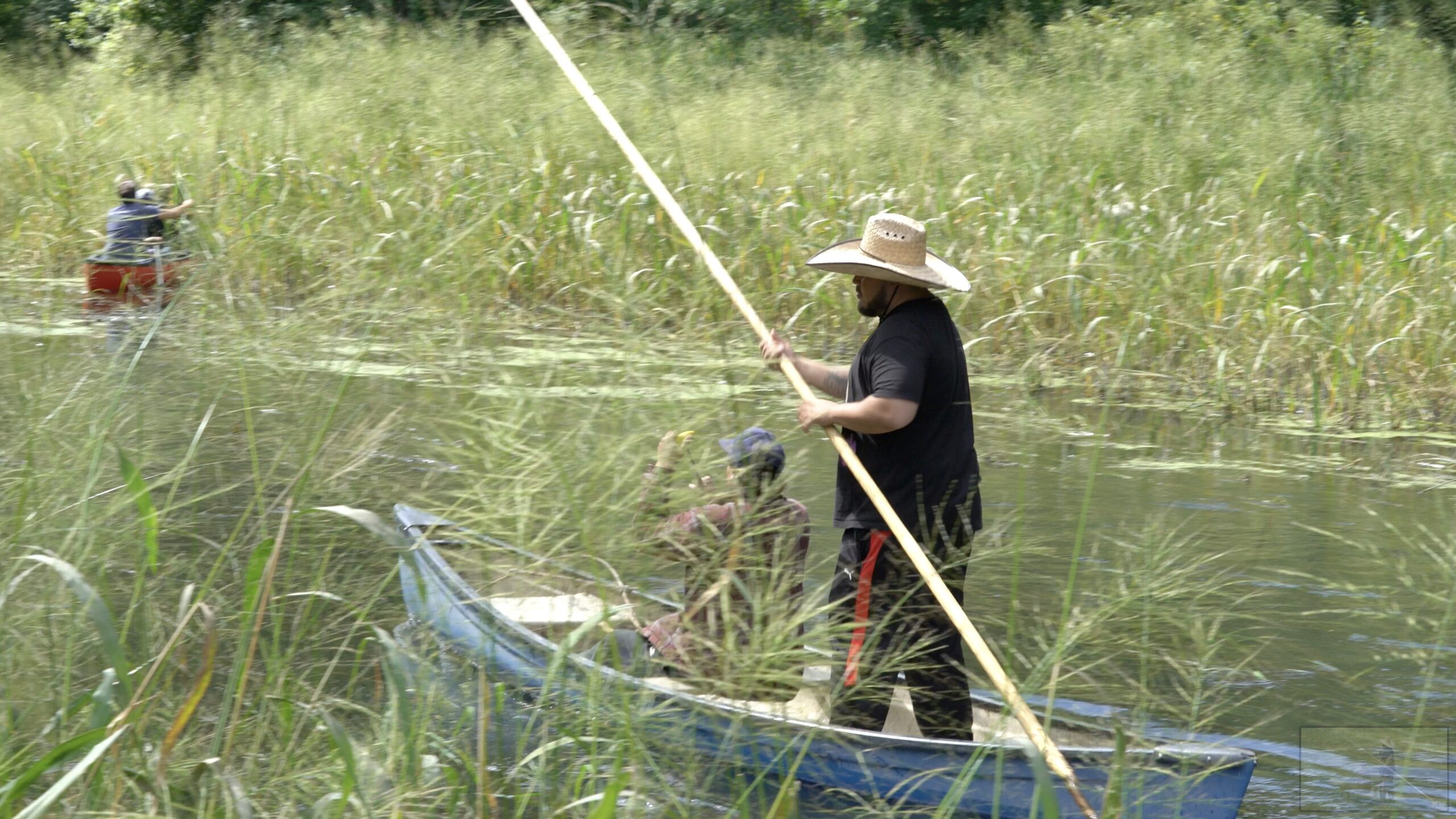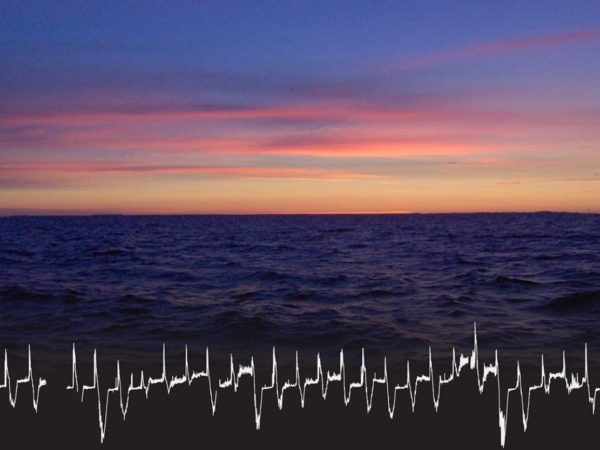
Great Lakes Moment is a monthly column written by Great Lakes Now Contributor John Hartig. Publishing the author’s views and assertions does not represent endorsement by Great Lakes Now or Detroit PBS.
Manoomin (mah-NOO-mehn) or wild rice was once very common in coastal marshes along the Detroit River and has always been sacred to First Nations. As Detroit became settled by Europeans, the river’s shoreline hardened with concrete breakwaters and steel sheet piling for commerce and industry, and the river’s water quality deteriorated from pollution, wild rice diminished greatly. Today it is listed as a threatened species in Michigan and the Nottawaseppi Huron Band of the Potawatomi wants to restore this species in the Detroit River and to identify it as an indicator of ecosystem health.
Wild rice is the only grain native to North America and was once common across the Great Lakes region. It is found in shallow waters of inland lakes, slow-flowing streams, and Great Lakes embayments and coastal areas. It usually occurs in water less than two feet deep in areas with a slight current over a mucky or silty bottom. There are actually two species of wild rice in Michigan—Zizania palustris that is adapted to cooler climates and Zizania aquatica that is adapted to warmer climates.
Early Indigenous peoples lived along the banks of the Detroit River and viewed wild rice as sacred and a gift giver. Historian George Cornell in his description of Indigenous life at Wawiiatanong — which roughly translates to “the place on the curve or bend of the [Detroit] river” — noted: “The river course and wetlands were also excellent mediums for wild rice where the water levels were consistent over time. Wild rice was an important foodstuff since it had the capacity to be stored for long periods of time in pottery vessels or bark containers.”
Huron and Potawatomi villages were located along the Detroit River near the confluence with the Rouge River. Wild rice was common in this area and provided food for tribal members. It also attracted ducks that provided sustenance to Indigenous peoples.
During the 18th Century, coastal wetlands were extensive along the Detroit River, growing up to a mile wide along both sides of the river. Vegetation types included submersed marsh, emergent marsh, wet meadow and shrub swamp, swamp forest, and lakeplain prairie — a type of wetland on seasonally wet ground of glacial lakeplains. Since 1815, the Detroit River ecosystem has undergone dramatic changes through shoreline and channel modifications like dredging that destroyed habitats and substantially reduced wetlands.
The largest habitat change was human encroachment into the river and hardening of the shoreline by the addition of steel sheet piling, concrete breakwalls and fill material. By 1982, 97% of the coastal wetlands on both sides of the Detroit River had been lost to development, and including wild rice.
Numerous islands in the Detroit River, like Belle Isle and Grosse Ile, had wild rice growing in the marshlands surrounding them. Located just off the mouth of the Detroit River in western Lake Erie is Pointe Mouillee State Game Area. Reports from 1910 noted that there were substantial beds of wild rice. Unfortunately, high water levels in the 1940s had a devastating impact on this emergent vegetation marsh. Seven species of emergent aquatic plants, including wild rice, disappeared and were replaced by submerged aquatic plants. Reports noted that wild rice tried to make a comeback but was out-competed by invasive cattails. By 1949, emergent plants had reestablished in one-fifth of the marsh, but heavy browsing by muskrats and uprooting of these plants by carp were suspected of diminishing the abundance of wild rice and soon it disappeared from Pointe Mouillee.
According to Kevin Harris, cultural specialist of the Nottawaseppi Huron Band of the Potawatomi, for Indigenous peoples, wild rice is viewed as a gift from the Creator. It has been harvested as a staple food for hundreds of years and is used in ceremonies and as medicine. It is a culturally significant plant to the Anishinaabek (Odawa, Ojibwe, and Potawatomi). However, it remains in danger from habitat loss and degradation, climate change, uninformed harvesting practices, water pollution, and other human threats.
“Wild rice is sacred to the Potawatomi,” Harris said. “In our Creation story, we have been told to find the food that grows on water and this is home.”
Harris said, that the Nottawaseppi have a spiritual connection to clean water, fish, waterfowl, and wild rice. These natural resources connect current tribal members with their ancestors and the Creator. In respect for the Earth, the Nottawaseppi strive to cultivate resources like wild rice carefully and to be good stewards, while also providing a harvest for their families.
In December 2023, Michigan Gov. Gretchen Whitmer designated wild rice as the state grain. The Nottawaseppi Huron Band of the Potawatomi played an important role in advocating for this designation, since 2017.
In response to the substantial loss of wild rice, tribes, including the Nottawaseppi, are leading a statewide effort to revive this Michigan state grain.
“The Nottawaseppi want to re-establish our presence along the Detroit River,” said Harris. “One of the ways we want to do this is to re-establish a variety of wild rice called river rice that is adapted to flowing waters.”
The Nottawaseppi are interested in partnering on a demonstration project to restore wild rice in protected areas in and along the Detroit River. Possible river locations include:
- Belle Isle
- Celeron and Stoney Island Units of Pointe Mouillee State Game Area
- Humbug Marsh, Calf Island, Sugar Island, Mud Island, Grassy Island/Mama Juda Shoal, Gibraltar Bay, or Gibraltar Wetlands Units of the Detroit River International Wildlife Refuge
- Six Points property owned by the Wyandot of Anderdon Nation
- Grosse Ile’s Gibraltar Bay
Wild rice is also considered an indicator of ecosystem health. It is like the canary in the coal mine. Wild rice grows in emergent wetlands with high water quality. When water quality declines, so does wild rice. The Nottawaseppi also want to see this important plant species identified as an indicator of ecosystem health for the Detroit River and included in the next ecosystem health assessment performed by partners under the State of the Strait Conference.
John Hartig is a board member at the Detroit Riverfront Conservancy. He serves as a Visiting Scholar at the University of Windsor’s Great Lakes Institute for Environmental Research and has written numerous books and publications on the environment and the Great Lakes. Hartig also helped create the Detroit River International Wildlife Refuge, where he worked for 14 years as the refuge manager.
Catch more news at Great Lakes Now:
Great Lakes Moment: Birds of a feather flock together
Great Lakes Moment: Detroit River’s important role in lake whitefish
Featured image: Kevin Harris of the Nottawaseppi Huron Band of the Potawatomi push poling during wild rice gathering (Photo courtesy of Nottawaseppi Huron Band of the Potawatomi).




